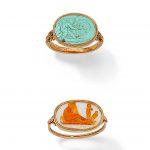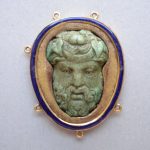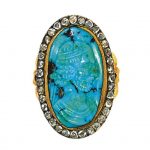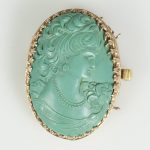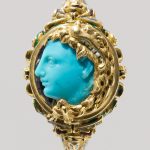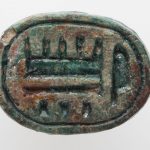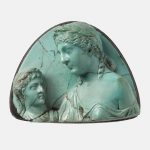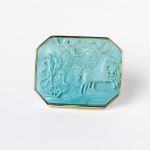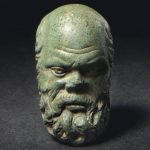The pastel shades of turquoise have endeared it to many great cultures of antiquity: it has adorned the rulers of Ancient Egypt, the Aztecs (and possibly other Pre-Columbian Mesoamericans), Persia, Mesopotamia, the Indus Valley, and to some extent in ancient China since at least the Shang Dynasty. Despite being one of the oldest gems, probably first introduced to Europe (through Turkey) with other Silk Road novelties, turquoise did not become important as an ornamental stone in the West until the 14th century, following a decline in the Roman Catholic Church’s influence which allowed the use of turquoise in secular jewellery. It was apparently unknown in India until the Mughal period, and unknown in Japan until the 18th century. A common belief shared by many of these civilizations held that turquoise possessed certain prophylactic qualities; it was thought to change colour with the wearer’s health and protect him or her from untoward forces. Reference: Wikipedia
Two cameo rings 1st: The collet-set oval turquoise plaque carved to depict Cupid with his hand in the Bocca della Verita, in a carved late 18th century mount. 2nd: The collet-set oval agate plaque depicting a seated figure regarding a small statue, in a mount circa 1830, ring size, 1st: H, 2nd: P½
Sold for £2,000 inc. premium at Bonhams in 2016
Cameo; turquoise; bearded head of Bacchus to front, wearing ivy-wreath; in gold mount with blue enamel and six loop projections. 16thC
Reference: © The Trustees of the British Museum
A diamond and turquoise cameo ring The oval bezel set with a turquoise cameo carved as the head of a Near Eastern potentate in profile facing right, within rose cut diamond border with fretted openwork reverse and foliate shoulders, the cameo circa 1780, the mount 19th century, finger size L
Sold for GBP 5,500 at Christies in 2012
Turquoise Matrix Cameo Pin The 18 kt. yellow gold twisted wire frame of triangular outline, retaining a carved turquoise cameo against a turquoise matrix ground.
Reverse side of stone included. Turquoise in good condition, base stone has one crack near head. Triangular, 2 3/4 inches at widest point.
Sold for $298 (includes buyer’s premium) at Doyle New York in 2004
An antique brooch, composed of a 14kt yellow gold foundation with prongs encompassing the oval, carved turquoise cameo of a smiling woman. Fitted with a removable push tab, allowing it to be used as a pendant. Not marked. CIRCA: Late 19th-Early 20th Ct. DIMENSIONS: H:1.75″ L: 1 2/8″ Total Weight:16.8 DWT CONDITION: Great condition.
Sold for $240 at Akiba Antiques in 2018
Cameo ring possibly of Alexander the Great mid-16th century; cameo: early Hellenistic 4th century B.C. This vibrant carving has previously been described as made of glass and as a product of the French Renaissance, but it is in turquoise, a rarity in cameos of any period. That it is reputed to have been in the Este collections may make an Italian origin likelier. It is not to be ruled out even that the stone is Hellenistic, from as early as the fourth century B.C., but the heroic type of Alexander the Great’s profile was adopted by various Hellenistic successors. In any case, the person who caused it to be set surely thought of it as ancient and as representing Alexander. It is probably a fragment whose broken edges the goldsmith has deftly concealed by forming the bezel as a lion skin, a motif that Alexander borrowed from Hercules.
Reference: The Metropolitan Museum of Art
A small scarab seal of turquoise glazed Egyptian faience. The scarabaeid beetle body has incised morphological detail on the rounded top and a flat underside which features a hieroglyphic character carved in intaglio as a seal. The body of the scarab is pierced from head to tail for suspension.
Reference: Museum of Applied Art and Sciences
Cameo with Livia holding a bust of Augustus (?) Roman Imperial Period A.D. 14–37
Bust of Livia in the guise of Venus Genetrix, with closely clinging drapery slipping off her left shoulder. Beside her is a youthful male head, which must originally have belonged to a bust or full-length figure, alternately identified as a bust of the deified Augustus, or as one of her sons, Tiberius or Drusus I. The cameo has been set into a modern setting. The lower part of the gem is damaged, and a portion of the original has clearly been lost.
Reference: Museum of Fine Arts Boston
Gold, Hardstone Cameo and Enamel Necklace Supporting cameos in the form of Pharaoh heads composed of lapis lazuli, brown jasper, green jasper, red jasper and turquoise, spaced by lotus flower motifs, applied throughout with enamel in red, white, blue, green and turquoise hues, decorated with granulation and twisted gold wire accents, length 15¼ inches; last quarter 19th century. With fitted case signed C. Roccheggiani.
Sold for 52,500 USD at Sotheby’s in 2016
Octagonal cameo. Depicting the Rape of Proserpine. In a chariot pulled by three galloping horses Pluto is abducting Proserpine. Both are naked. Pluto wears a crown and carries a long-handled fork or trident; he bestrides the chariot, grasping Proserpine around the waist. Proserpine is in an attitude of resistance, with her foot lifted behind her, and one hand struggling with his hand, her head flung back and her hair flying. In the sky above are two winged putti, one with a flaming torch over Pluto, the other holding the reins and urging the horses on with a whip.
Reference: © Victoria and Albert Museum
